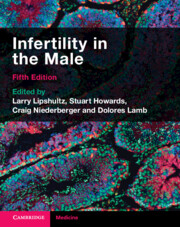Book contents
- Infertility in the Male
- Infertility in the Male
- Copyright page
- Contents
- Contributors
- Foreword
- Abbreviations
- Introduction
- Section 1 Scientific Foundations of Male Infertility
- Section 2 Clinical Evaluation of the Infertile Male
- Chapter 7 Infertility as a Metric of Men’s Health
- Chapter 8 Office Evaluation of the Subfertile Male
- Chapter 9 Evaluation of the Infertile Male’s Partner
- Chapter 10 Imaging the Male Reproductive System
- Chapter 11 Effects of Environmental Chemicals on Male Reproduction
- Chapter 12 Endocrine Causes of Male Infertility – Diagnosis and Treatment
- Chapter 13 Spermatogenesis – Diagnosis of Normal and Abnormal States
- Chapter 14 Inheritance and Male Fertility
- Chapter 15 The Varicocele – Approaches to Diagnosis and Management
- Chapter 16 Infection, Inflammation, and Immunological Causes of Male Infertility
- Section 3 Laboratory Diagnosis of Male Infertility
- Section 4 Treatment of Male Infertility
- Section 5 Health Care Systems and Culture
- Index
- References
Chapter 12 - Endocrine Causes of Male Infertility – Diagnosis and Treatment
from Section 2 - Clinical Evaluation of the Infertile Male
Published online by Cambridge University Press: 08 July 2023
- Infertility in the Male
- Infertility in the Male
- Copyright page
- Contents
- Contributors
- Foreword
- Abbreviations
- Introduction
- Section 1 Scientific Foundations of Male Infertility
- Section 2 Clinical Evaluation of the Infertile Male
- Chapter 7 Infertility as a Metric of Men’s Health
- Chapter 8 Office Evaluation of the Subfertile Male
- Chapter 9 Evaluation of the Infertile Male’s Partner
- Chapter 10 Imaging the Male Reproductive System
- Chapter 11 Effects of Environmental Chemicals on Male Reproduction
- Chapter 12 Endocrine Causes of Male Infertility – Diagnosis and Treatment
- Chapter 13 Spermatogenesis – Diagnosis of Normal and Abnormal States
- Chapter 14 Inheritance and Male Fertility
- Chapter 15 The Varicocele – Approaches to Diagnosis and Management
- Chapter 16 Infection, Inflammation, and Immunological Causes of Male Infertility
- Section 3 Laboratory Diagnosis of Male Infertility
- Section 4 Treatment of Male Infertility
- Section 5 Health Care Systems and Culture
- Index
- References
Summary
Infertility is generally defined as the inability to achieve conception after 12 months of regular unprotected sexual intercourse (World Health Organization (WHO)) [1]. It is estimated that approximately one-third of infertility cases are due to male factor infertility, another one-third due to female factor infertility, and the remainder due to combined male and female factors or unexplained cause(s). A recent large cross-sectional study suggests that about 10.1 percent of men experience infertility [2], and in a birth cohort study, in men aged 38 years, male infertility ranged from 14.4 to 21.8 percent [3]. Endocrine causes of male infertility are surprisingly infrequent, given that fertility is dependent on an intact hypothalamic–pituitary–testicular (HPT) axis (see Chapter 4) for adequate spermatogenesis. Systemic endocrine diseases and disturbances of the HPT axis comprise approximately 2 to 5 percent of causes of male infertility [4, 5]. Though uncommon, endocrine causes of infertility are important to diagnose, as specific treatment is available in most cases to ameliorate the clinical symptoms of hypogonadism and, in some instances, for treatment of infertility. Understanding the underlying endocrine etiology of infertility allows for shared decision-making in the management of a couple with infertility; furthermore, certain conditions may have serious health consequences if left untreated. Evaluation of endocrine causes is essential when investigating male factor infertility.
- Type
- Chapter
- Information
- Infertility in the Male , pp. 197 - 217Publisher: Cambridge University PressPrint publication year: 2023



